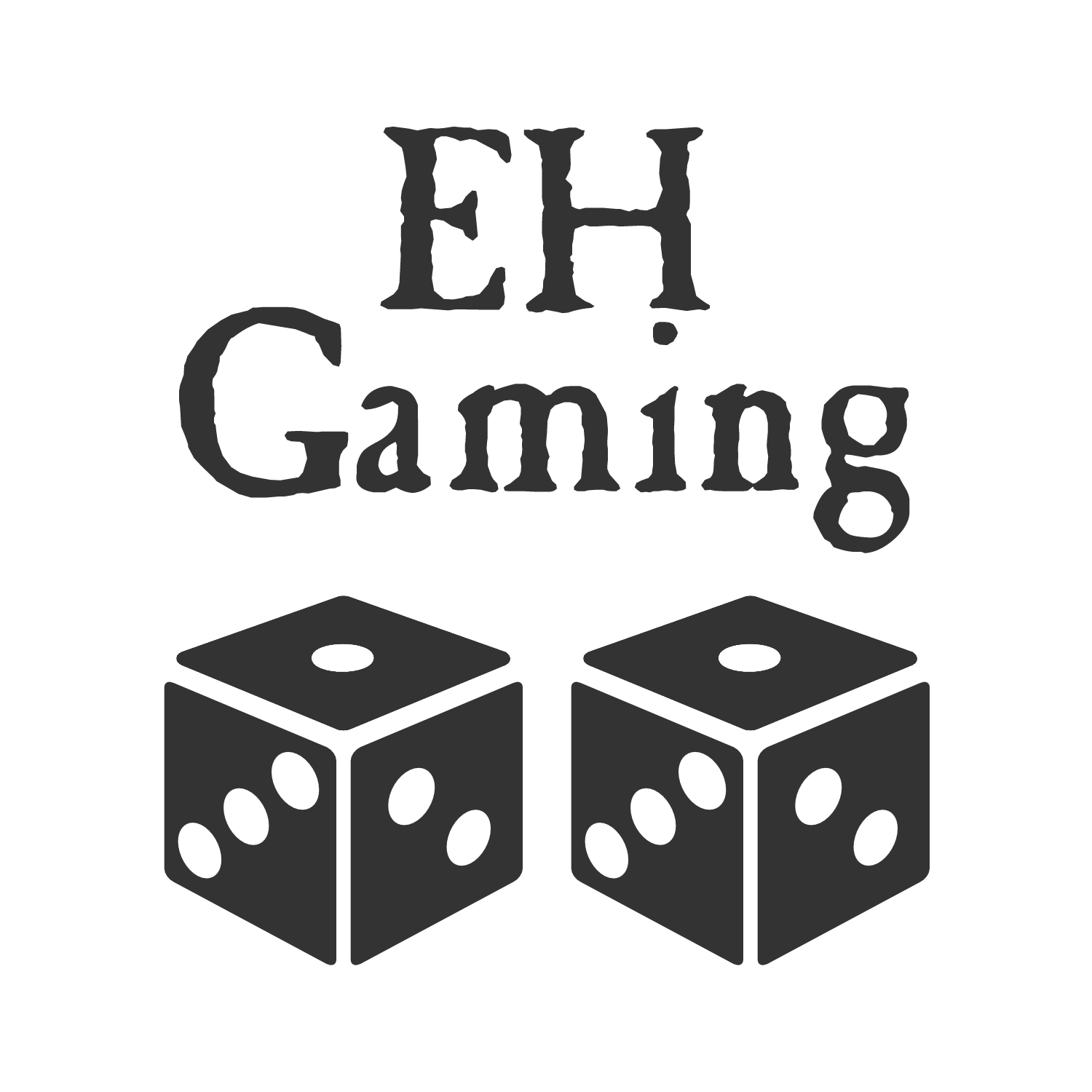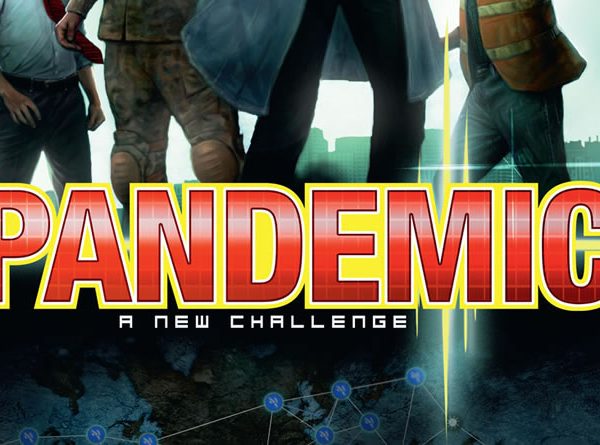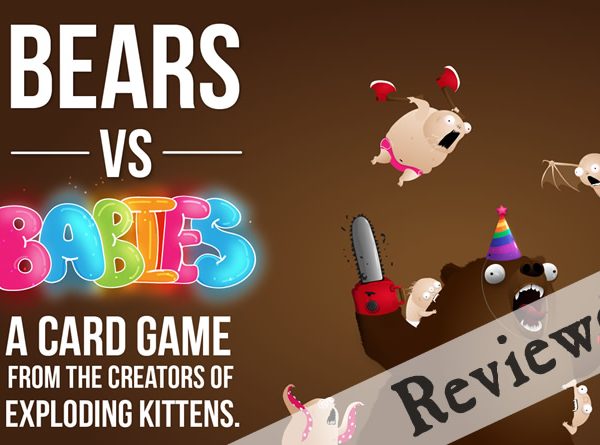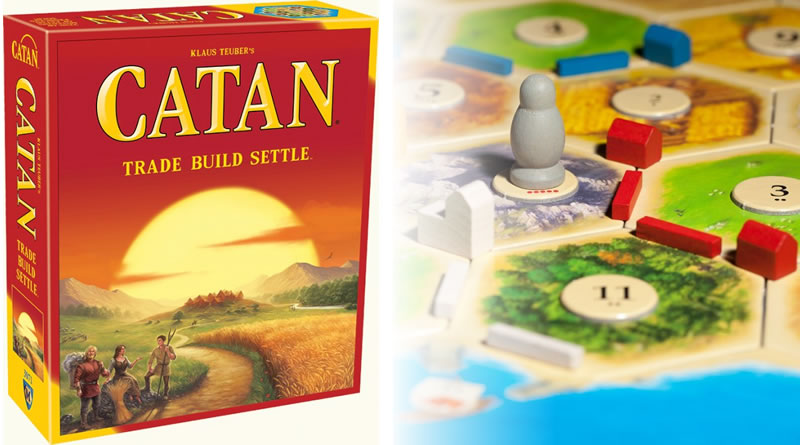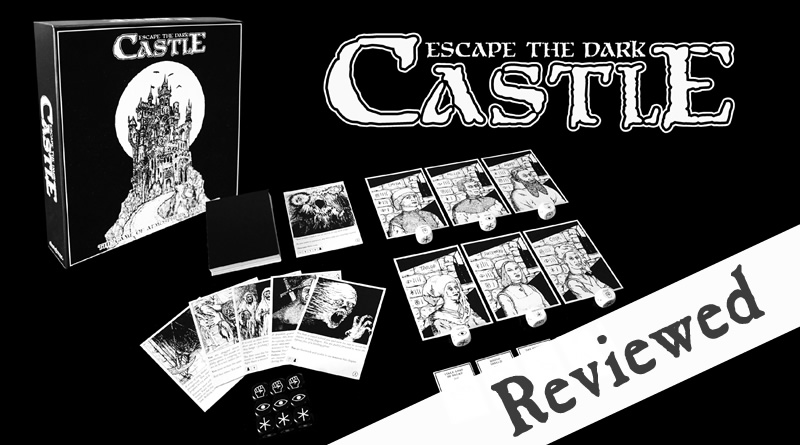
This game seemed to seep into my mind through a form of osmosis, and I can’t put my finger on exactly when it first got in there, but it wriggled more and more over the weeks leading up to UK Games Expo. I knew I wanted to learn more about it, but didn’t actually know what it was and didn’t get chance to do any research at all before the event…and I am so glad I discovered it with no preconceptions or expectations.
It was the art that had drawn me in…it took me back to my formative years, reading (playing?) The Warlock of Firetop Mountain book with a torch under the covers after mum had told me to go to sleep.
Come on mum, I was 27 years old!
Pah, actually 11 or 12 at the time and these books were all the rage as we would have to wait another 15 years before the internet became a ‘thing’ and the ‘choose your own adventure’ books gave us something to do while we waited 20 minutes for a game to load from the cassette machine on our Sinclair Spectrums (or Commodore 64 if you were posh). The pictures inside were creepy, but in a good way and added atmosphere to the games (books?) and just brought them to life in the way that a good dungeon master should.
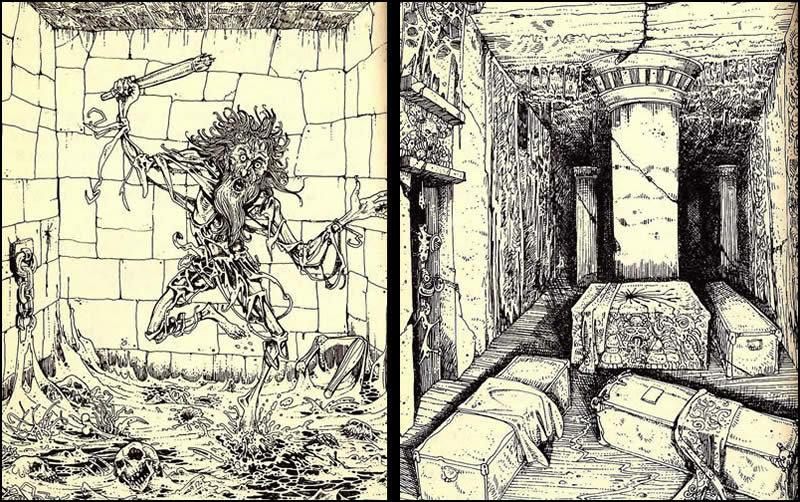
But art is subjective; always has been and always will be, and the art of this game has hit me right in the solar plexus before bashing me over the head with a club made of the purest nostalgia.
So, the question I needed an answer to was “is there an actual game behind this potential schmaltz?”…
What’s in the box?
- 45 Chapter Cards
- 35 Item Cards
- 6 Character Cards
- 3 Boss Cards
- 1 Start Card
- 9 Chapter Dice
- 6 Character Dice
- 1 Scorepad
- 4 Pencils
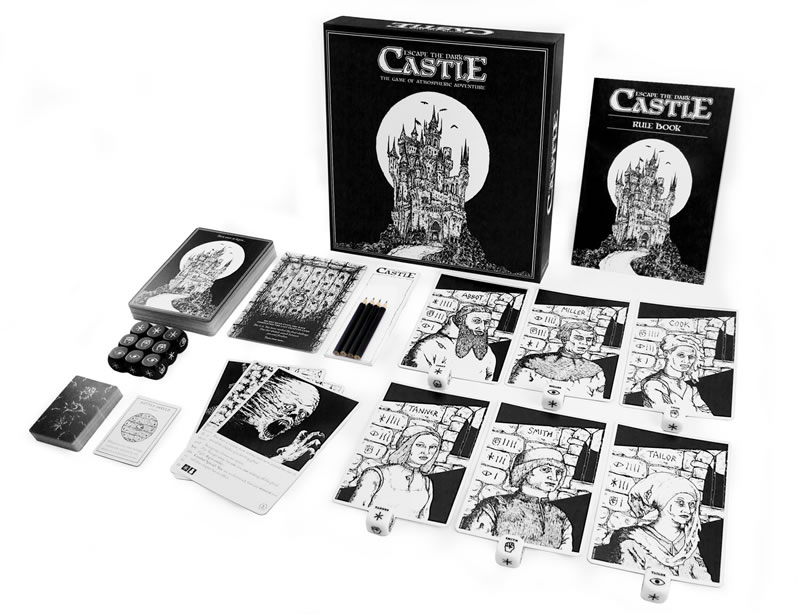
Basic Game Overview
Playing solo, or with up to three other people, Escape The Dark Castle sees you finally getting a chance to flee to freedom after many years of being locked up (wrongfully) in said dark castle, and so the adventure begins.
Each player picks a character to play with, taking notice of the relative strengths and weaknesses and takes the Character Card and their dice. The Item Cards are shuffled and placed face down. The Chapter Cards are shuffled and fifteen of these are placed face down in a deck on the table. The three Boss Cards are shuffled up and one is placed face down at the bottom of that deck with the Start Card placed face down on top and you’re good to go
It is worth noting that the characters you choose from are not majestic heroes or magical elves and fearsome dwarves; quite the opposite – they are normal run of the mill every day dudes (and dudettes) who have been locked up for years and desperate to get the hell out of there. It is likely they know that the escape bid will not be easy as they must have heard some sinister stuff from their cells over the years but it would appear that freedom with an immense chance of death is far more suited to their tastes than one more day of incarceration!
I love the normality of the characters, with their ragged clothes and haunted gaunt faces. I actually WANT to help them and see them escape…I feel really sorry for them. The Abbot is my usual homeboy of choice…he was the first character I ever used and I religiously (see what I did there?) stick by him every time.
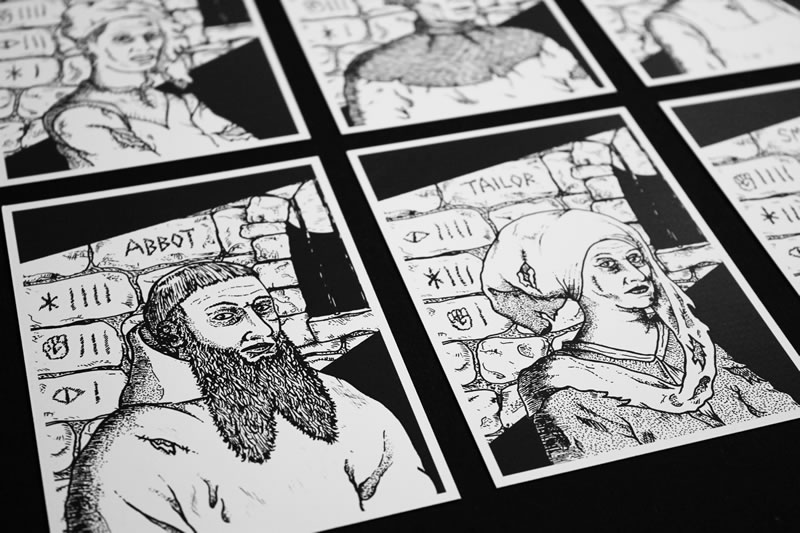
Each character has a varying blend of three main character aspects; Might, Cunning and Wisdom. These are potrayed through basic symbols; fist for might, eye for cunning and a star for wisdom. In case you missed it, take a look at the Character Card picture above again and you can see the relative strength and weaknesses in these three areas ‘scratched’ onto the cell wall over a character’s shoulder.
The weight of these characteristics is played out through the individual dice that is associated with the character. For example, the Abbot is heavy on Wisdom, medium on Might and low on Cunning. His D6 character dice therefore has three sides for Wisdom, two sides for Might and only one side for Cunning to pretty much perfectly reflect his character strengths and weaknesses when rolling. The Tailor is strongest in Cunning, medium on Wisdom and low on Might so she has three sides, two sides and one side in those areas respectively. The Smith is strongest in Might but lowest in Cunning, and so on and by combining your ‘team’ of characters carefully you can create a well balanced force which will vastly increase your chances of escaping as you will need to roll all of these symbols through the game.
Like all good adventure games, the characters have a set number of health points and in Escape The Dark Castle the value is set depending on how many players are in the game. 1 or 2 players is 18 health points each, 3 players is 14 and 4 players is 12 points each.
With your characters chosen and the deck of cards all set up you turn over the Start Card and the scene is set. In a nutshell, you’ve busted out of your cells and your escape begins…but the Start Card sets the scene far better that I just did!
You do get to grab an Item Card each at this stage, and these are drawn from top of the deck and have varying degrees of assistance through the game. Some may seem useless at first blush but may end up saving your skin deeper into the story. Relics are generally very, very useful though so cherish those.
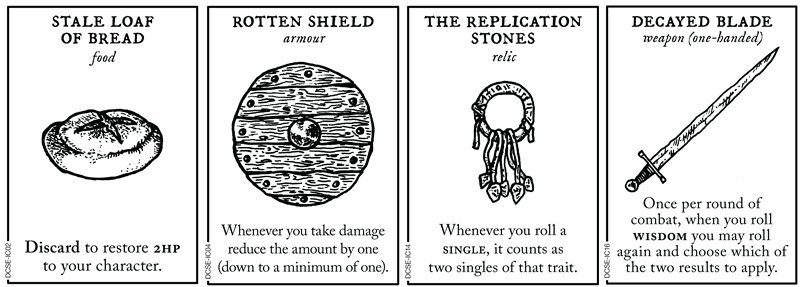
Items can be used at any time in the game, unless the card specifies otherwise and you can also swap items between players before a new chapter card is turned over. Two Item Cards can be carried at any time per player as a maximum.
It is worth highlighting that there is no actual turn order in this game. You work as a team and as such make decisions together and one of the most important decisions is who is going to turn a Chapter Card over as that is the player who faces the encounter first. At the start of the game it is relatively moot who goes first, but later on it can become a very critical and strategic decision to discuss and make.
The first Chapter Card gets turned over and the first encounter is revealed, and this is to be read out to the group by the player who turned the card over. Here is an example of a Chapter Card…
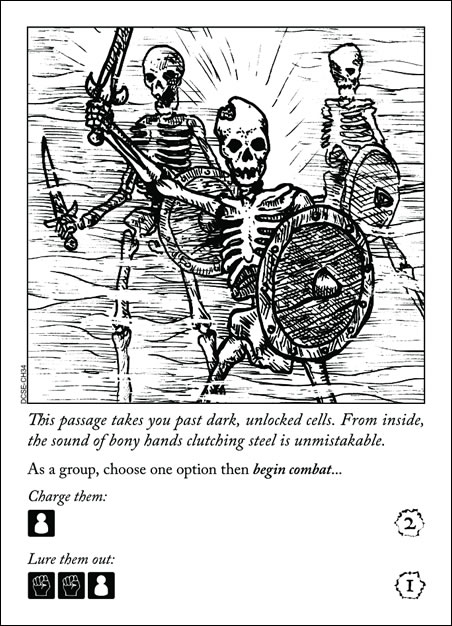
This is a good example as there is potentially plenty going on with this card and it highlights the discussions and decisions that need to be made and allows me to quickly explain how combat works as this card can only end in a scrap.
Combat is driven by symbols and is scaled depending on the number of players and this is where the Chapter Dice come into play. If you look at the bottom of the card above you can see a player symbol; the white ‘pawn’ shape on the black background. This symbol means that you roll a Chapter Dice for each player in the game, so in a three player game you would roll three of these dice. The Chapter Dice have an even mix of Might, Cunning and Wisdom symbols on them, so two sides for each attribute. Let’s say we opted to charge with this chapter and rolled the Chapter Dice and two Might and one Cunning symbol was the result.
This means that to defeat the skeletons then as a group we need to roll our Character Dice at the same time and hope for two Mights and one Cunning in the results. If we do that then we beat them and get to draw another Item Card for the group (just one, not one each) and then we move on to the next Chapter Card. If we failed to match those three symbol results, lets say we only rolled one Might and one Cunning, then for any symbols we did match we remove the corresponding Chapter Dice from the skeletons but then take damage from their attack. In the instance of the ‘Charge them’ choice you can see a number 2 on the right hand side of the card…this means we each take 2 damage so our health points reduce by two, unless any Character Dice rolls resulted in the double with the shield around it. If that happens then that player managed to block the counter attack and takes no damage. The group then rolls again, hoping to remove the final Chapter Dice from the skeletons and thus defeat them!
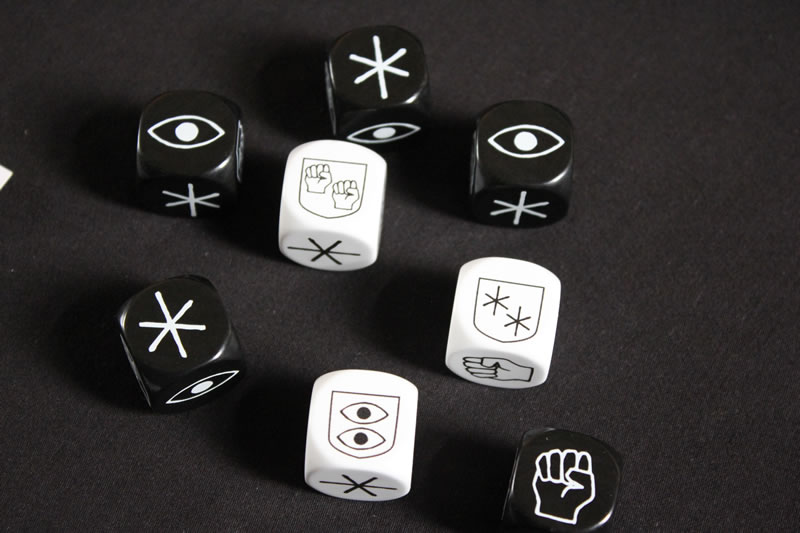
So, you can see with this card how there are often decisions that need to be taken as a group. The alternative to charging the skeletons is to ‘Lure them out’ but you can see that this has two Might symbols already next to the player symbol. This means that you would allocate two Might Chapter Dice and then roll another Chapter Dice for each player. Our group of three players would have to match five symbols in total during combat if ‘Lure them out’ is chosen, which is potentially much harder to achieve than the three symbols associated with ‘Charge them’? But if you look at the damage value on the right hand side of the card it is only one point with this option if you are attacked instead of two. If you have a player or two with strong Might characteristics then rolling the extra two Might results may not seem like a problem, but if your group doesn’t have much Might between them then you may struggle to win in one or even two rounds of combat.
These are decisions that you discuss and decide on as a group after weighing up the pros and cons. Also, what may seem like an easy decision early on in the game may actually be a completely different kettle of fish later on when half of your party is knocking on death’s door!
You play through the remainder of the Chapter Cards, if you survive, and then tackle the Boss at the end of the adventure, and these are much tougher than anything else you will have met up to that point!
What’s it like to play?
Escape The Dark Castle is a truly great game to play and especially so when you have a good group of enthusiastic people coming with you on the adventure. One of its core strengths is the cooperative nature of the game and only by playing as a team will you succeed and the game stimulates discussion and debate throughout whilst remaining very atmospheric and exciting.
There is a real tension that runs through the whole game and the stress of being the person who has to turn a Chapter Card over deep into the game is palpable, especially if it turns out to be a real humdinger that could almost finish one of your companions off. It is not uncommon for the person reading such a potentially devastating card out to be berated as if it is his or her fault that the card was there, but everyone pulls together and blesses the dice before they get rolled.
Everyone in the party is invested in the well-being of the other players as well as themselves because if one party member dies then the game ends.
Yes, it ends…no brave soldiering on with three players instead of four; you’re done. So making decisions that benefit the whole team rather than yourself is crucial for victory and this is one of the main aspects that makes Escape The Dark Castle such a thrilling social occasion.
It also plays at an exciting pace and a game with four players will rattle along and be done within half an hour (40 minutes max), but if you didn’t manage to escape then you will be setting it up again straight away and busting out of your cells one more time, so write off at least an hour, or maybe two?
The dice system is actually really straight forward but within its simplicity is a very compelling process of symbol matching which can be both exhilarating and hugely frustrating…but in a good way. Coupled with the random nature of the chapter cards the escape route can sometimes bless you with a run of perfect combat match ups or easy chapters where you walk away with a new shiny item without having to fight…or it can contrive to create a perfect storm of bad luck that can see your very healthy party soon having to shield and nurse a team mate back from the brink of death.
Who would like it?
This game will appeal to quite a number of different folk. If you have the nostalgia itch I have for the 1980s adventure books such as Warlock of Firetop Mountain, Deathtrap Dungeon and more then this is a MUST buy and you will love it as a game to play with friends and family and you will also love it as a solo adventure game. In fact, you’ll be happy just opening the box and looking at all the artwork on the cards and that alone is worth the price of the game itself.
Anyone who enjoys an RPG or a dungeon crawl game such as Silver Tower or Dungeon Saga is going to get on just fine with Escape From The Dark Castle and it may be a very good way to ease yourself into an evening of one of those games, but I am going to head that thought off at the pass. It’s too easy sometimes to look at a game that can be played in 30 minutes as a filler or something to play before or after other things. Yes, this game can be used in that way and you will have a blast but it is also worthy of an evening being built around it on its own. Dim the lights, light some candles; do anything you can to inject some theatre into procedings and you will have an amazing time, especially if everyone is bought into the experience.
I have said this before about games such as Carcassonne and Ticket To Ride, but if you have ever had at least one good time playing a board or card game in the past then you are very, very likely to have yet another good time with this. In fact, it would appear that Tom Vasel from The Dice Tower is the only person who seems to have come close to this game and not liked it…and I’ll eat one of his silly hats if he actually did properly try and play the game before he did his review.
There is a recommended age of 14+ on the box, and I do think you can come down two or three years from that and still be comfortable that no-one will have nightmares but anyone younger than this may find some of the artwork a bit scary so parents should use their discretion.
Summary
For me, this has been the purest and most perfect introduction to a game I have had in some time or perhaps ever. I hadn’t read any reviews or watched any videos about it and went to Themeborne’s stand at UK Games Expo with no knowledge about the game other than I knew I LOVED the artwork and the look and feel of the packaging.
To then be introduced to a truly enthralling game by one of the co-creators was a real treat and I was very fortunate that Thomas Pike was on hand to play a demo game with me (we escaped!!). I bought my copy there and then, and although this is only nine days ago at the time of writing I have already played it over twenty times and will be taking it away with me for some solo play while I stay away with work through this week. Special mention to the other two co-creators of the game, Alex Crispin and James Shelton…I salute you all!
It is a very difficult game to pigeon hole or label, so I won’t fudge around and try and do that. Instead of belonging to a genre or ‘type’ I see Escape The Dark Castle as nothing short of being a wondrous postmodern celebration of games, themes and ideas that have come before it that all sit in the middle of a venn diagram together. It’s a perfect mash-up of role playing games, choose your own adventure books, graphic novels, dungeon crawlers, card and dice games that is beautifully packaged and presented in a format that is so retro that it is in fact futuristic as this surfs on the edges of where I think the zeitgeist will be in the next couple of years.
And I should point out that the next couple of years look like they will be busy and productive as this game is ripe for expansions and as I write this there is already a heavily backed Kickstarter campaign live for two new expansions that smashed its target within 12 hours. This is on the back of the already available ‘Cult of the Death Knight’ adventure pack, so I see Escape The Dark Castle as a game that will be around for many years yet as it grows and develops and innovates again.
For me, this is one of the greats and time will see that through as it develops a cult status. It is far and away the best game I have played in 2018 and I don’t see that changing between now and the end of the year. My game of the show at UK Games Expo and likely to be my game of the year for 2018/19 if the current Kickstarter delivers on its promise…I have backed it and cannot wait!
Buy this game with confidence and enjoy…
Our Verdict

Scores 11 out of 12 for taking me back to my youth whilst also being a genuinely original and compelling experience!
Publisher: Themeborne
Designers: Thomas Pike, Alex Crispin & James Shelton
No. of Players: 1 to 4
Recommended Age: 14+
Time To Play: Around 30 minutes
RRP: £29.99 (buy from us for only £25.99)
